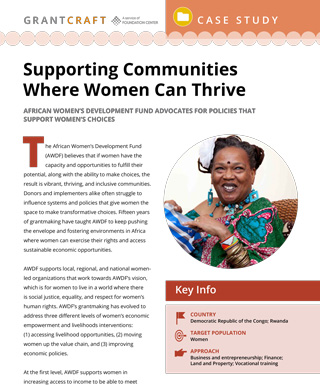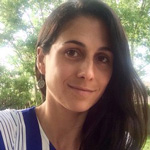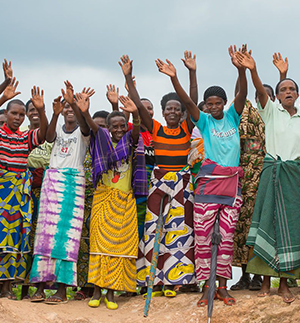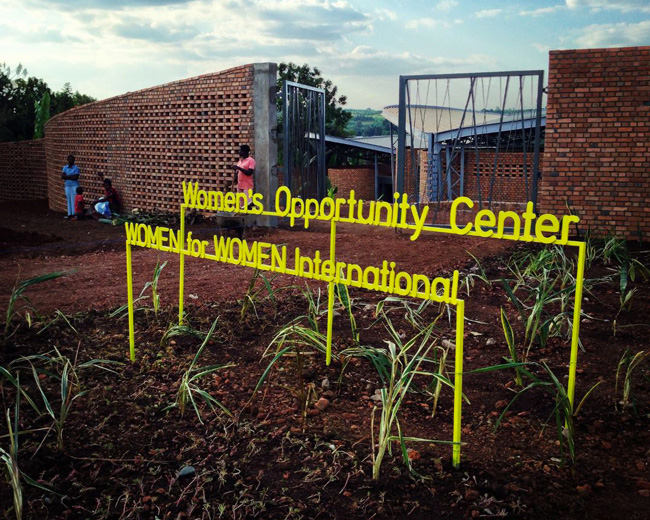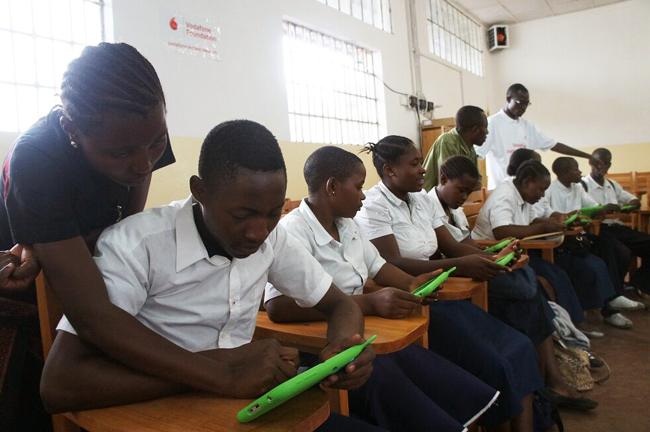Supporting Communities Where Women Can Thrive African Women's Development Fund Advocates for Policies That Support Women's Choices
The African Women’s Development Fund (AWDF) believes that if women have the capacity and opportunities to fulfill their potential, along with the ability to make choices, the result is vibrant, thriving, and inclusive communities. Donors and implementers alike often struggle to influence systems and policies that give women the space to make transformative choices. Fifteen years of grantmaking have taught AWDF to keep pushing the envelope and fostering environments in Africa where women can exercise their rights and access sustainable economic opportunities.
AWDF supports local, regional, and national womenled organizations that work towards AWDF’s vision, which is for women to live in a world where there is social justice, equality, and respect for women’s human rights. AWDF’s grantmaking has evolved to address three different levels of women’s economic empowerment and livelihoods interventions: (1) accessing livelihood opportunities, (2) moving women up the value chain, and (3) improving economic policies.
At the first level, AWDF supports women in increasing access to income to be able to meet their basic needs. AWDF’s grants at this level always include technical support along with funding. Sarah Mukasa, director of programs, explains,“If AWDF is no longer able to support a given group, we want to know that they can sustain their efforts.
This is why having a capacity-building component is so critical in helping our grantees and beneficiaries become a little more entrepreneurial in their work.”
At the second level, AWDF aims to help women move up the value chain, ensuring the longevity and sustainability of income-generating activities. This includes, but is not limited to, accessing markets, capital, credit, and infrastructure and agricultural extension support.
At the third level, AWDF works to inform and shape economic policies at local, regional, and national levels to address the opportunities and challenges women face in moving up the value chain. This is the newest level of intervention for AWDF and is most directly derived from reflecting on past funding scenarios.
AWDF has historically focused more resources on the first two levels, in response to the requests and needs of its grantees and beneficiaries. “Over time, we have realized that we play a key role in shaping the policy agenda and therefore have to invest “AWDF has always believed that if women have the resources, the skills, and the knowledge, they will be able to craft an agenda that responds to their needs.” —Sarah Mukasa, African Women’s Development Fund more at this third level, too,” explains Sarah. AWDF’s overall grantmaking agenda now aims to strengthen women’s leadership, visibility, and influence at all levels in which they operate. Sarah shares that most women in Africa who work do so in very low-paying jobs, in precarious working conditions, and with little job security. This is why it is so important for AWDF to address women’s economic empowerment and livelihoods at all levels of intervention—from developing women’s skills to influencing policies.
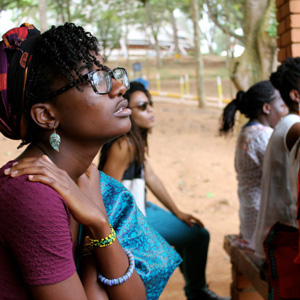 AWDF strictly funds women-led initiatives that expand the livelihood choices of women from the most marginalized communities, including women living with HIV/AIDS, women from minority ethnic groups, young women, and sexual minorities. For example: in a small community in Rwanda, women lacked livelihoods opportunities. They decided that if they had the skills and materials to become beekeepers, a traditionally male profession, they could sell honey in the local market and earn an income. The women needed land on which to build and maintain the beehives. AWDF saw the prospect for these women to (1) generate income, (2) enter the formal market, thereby moving up the value chain, and (3) access land, which thwarted the traditional paradigm of land ownership only by men. AWDF invested through a local grantee in garnering community leadership buy-in, which resulted in the community chief donating land to this group of women. This is one example of how AWDF leveraged its role to not only expand the livelihood opportunities for a group of women, but also influence the space for these women to undertake a non-traditional economic activity, and through doing so, become landowners.
AWDF strictly funds women-led initiatives that expand the livelihood choices of women from the most marginalized communities, including women living with HIV/AIDS, women from minority ethnic groups, young women, and sexual minorities. For example: in a small community in Rwanda, women lacked livelihoods opportunities. They decided that if they had the skills and materials to become beekeepers, a traditionally male profession, they could sell honey in the local market and earn an income. The women needed land on which to build and maintain the beehives. AWDF saw the prospect for these women to (1) generate income, (2) enter the formal market, thereby moving up the value chain, and (3) access land, which thwarted the traditional paradigm of land ownership only by men. AWDF invested through a local grantee in garnering community leadership buy-in, which resulted in the community chief donating land to this group of women. This is one example of how AWDF leveraged its role to not only expand the livelihood opportunities for a group of women, but also influence the space for these women to undertake a non-traditional economic activity, and through doing so, become landowners.
Another example: In the Democratic Republic of Congo (DRC), AWDF funded a project that provided indigenous women with training in techniques of soap-making. Pygmies in DRC are a very marginalized ethnic minority of hunter-gatherers. They live mainly in the forest and have limited skills to integrate into modern society. As urban communities spread, the indigenous habitat and lifestyle are threatened. Women from one indigenous community were found making a daily living from begging or very low paid, unprotected domestic work. Many women were forced into the sex trade just to make ends meet. AWDF aimed to provide these indigenous women with a safer and more sustainable opportunity to generate income.
AWDF funded a local organization that trained these women in soap-making and basic business skills, including basic arithmetic, marketing skills, packaging, and stock management. The project then aimed to integrate the indigenous women into the mainstream community market. The women now had a product (soap) to sell in the local market, allowing them to integrate into the value chain. Without that access, the ability to make soap alone would not result in a sustainable economic livelihood. The indigenous women used their income to pay school fees so that their children could attend the local school to better assimilate into the main community and, in turn, garner greater awareness and acceptance of their own community.
Community mobilization is vital to the success of any project. In particular, if a project challenges norms or traditional roles and responsibilities, leveraging community support and buy-in from local leadership is vital in creating the space and good will for the women’s initiatives. Sarah explains that a negotiating or dialoguing process should be integrated by funders or implementers from the inception of any project. “When more groundwork has been done to inform the community and ensure leadership buy-in, the project has the space to be successful and the rest is smoother as a result. Many of the groups we fund have been doing some work around buy-in at a very micro-level. AWDF’s goal is to capitalize on the existing investment and scale up for greater impact.”
When trying to influence policies, AWDF still has a lot of unanswered questions. To what extent are local, district, and national leaders addressing critical issues such as land ownership and inheritance for women? How can female farmers or entrepreneurs expand their products beyond their community or district? What support do micro-level women’s organizations need? What are key macroeconomic issues affecting women’s economic development? What are governments doing to support women’s ability to access opportunities? Influencing policy is still somewhat of an aspirational component of AWDF’s “Beneficiaries invest more in a project that they have helped craft and been able to steer. It should be something that was conceived with local knowledge and influence, that women have worked for or worked with over a period of time.” —Sarah Mukasa, African Women’s Development Fund three-level approach. “We’re still trying to put a finger on how best to address this in the various contexts in which we work, but we know we have to dig in and keep trying,” shares Sarah.
One key factor remains constant in driving AWDF’s work—women must lead the design and process of any project that aims to address their needs. “We are very keen that it is the women who decide the agenda, it is the women who decide how resources are going to be invested, and it is the women who are involved in the implementation, monitoring and follow-up,” explains Sarah. Donors and implementing organizations can advise and support, but women must be at the helm of the choices that they make and they must be the drivers of that agenda. “Our role as funders is to support scale up and advocate for a space in which women can make transformative choices and access equitable opportunities,” explains Sarah. “Advocacy and policy is some of the toughest work in the field of development, but donors are meant to undertake the most difficult challenges.”
This case study was developed for Foundation Center's Equal Footing project.
